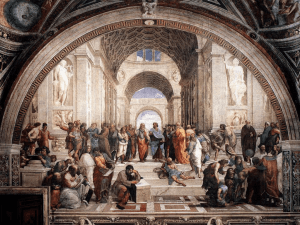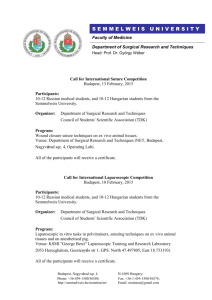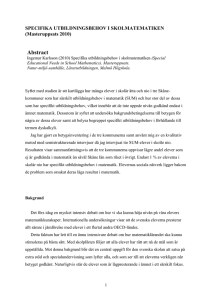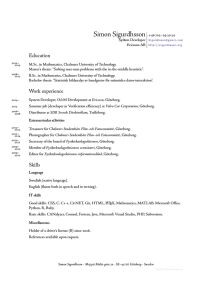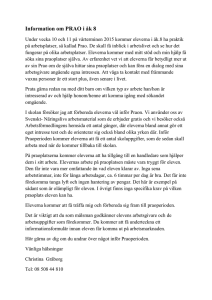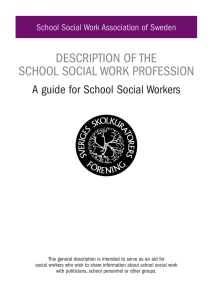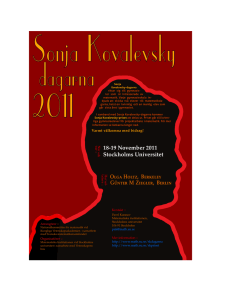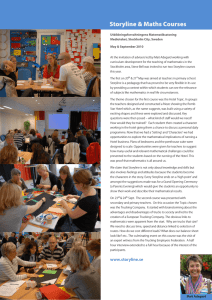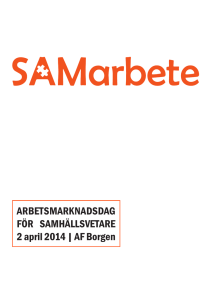Maria Wærn
advertisement
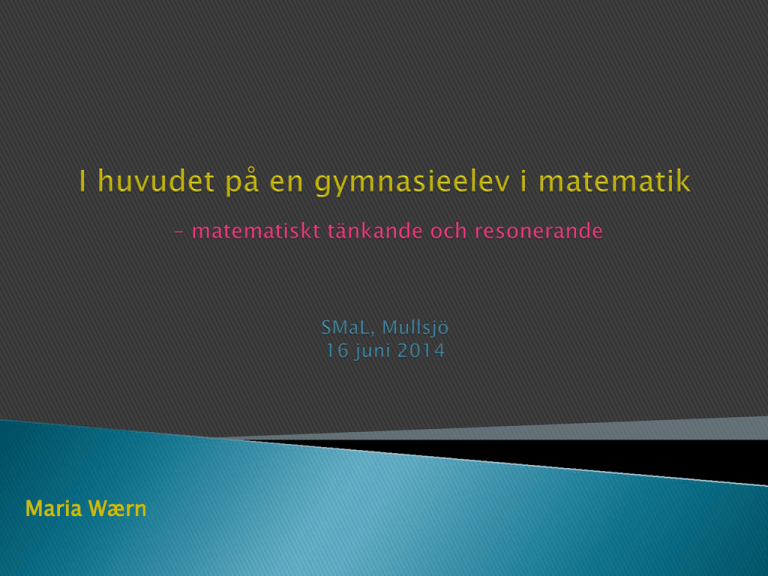
Maria Wærn Att undersöka när och hur mina elever börjar tänka och resonera mer matematiskt ? Hur uppfattar eleverna sitt eget lärande i matematik? 2 Med hjälp av olika matematiska aktiviteter som vi har använt o Vilka aktiviteter påverkar elevernas matematiska tänkande och resonerande? o Hur uppfattar eleverna sitt lärande i matematik med dessa aktiviteter? o Gör vi något annat som påverkar elevernas matematiska tänkande och resonerande i hög grad? 3 Eleverna vid IB-programmet, Åva Gymnasium, Täby Läsåret 2012/2013 Fokus på elever i pre-IB Ma 1B, Ma 1C och del av Ma 2C på engelska Fokus på elever i IB2 De har gjort pre-IB vid Åva och de har valt Mathematical Studies eller Mathematics Standard Level IB = The International Baccalaureate, se www.ibo.org (ett internationellt universitetsförberedande program) 4 Definition • • En lektion som bara innehåller ett matematiskt problem Problemen är ofta undersökande uppgifter, öppna frågor, rika problem eller en enkel uppgift som fokuserar på matematiska procedurer eller begrepp • Problemen är enkelt formulerade så att alla kan förstå • Alla elever arbetar med samma problem i små eller stora grupper • Vissa problem kräver en grafritande räknare • Resultatet sammanfattas i slutet av lektionen 5 Tre utvalda aktiviteter Intervjuer efter olika aktiviteter med elever i pre-IB (totalt 9 intervjuer) Eleverna intervjuade parvis Tre olika elevgrupper efter varje aktivitet – Urvalsförfarande? Intervjuerna gjordes en vecka efter genomförd aktivitet Intervjuer med tre olika elever i IB2 som har gjort samma och andra aktiviteter under nästan tre års tid (totalt 3 intervjuer) Eleverna intervjuades enskilt Eleverna fick tid att förbereda sig för intervjuerna 6 The Gradient Little Boxes Generalizations in Geometry 7 Dra en rät linje mellan två punkter i ett koordinatsystem. Mät lutningen av linjen. Flytta en av punkterna så att mätvärdet för lutningen ändras. Jämför och diskutera. Finn en generell metod för hur lutningen kan bestämmas av punkternas koordinater! The Gradient Quiz – The Gradient Resultat pre-IB 100% - 7 students 75% - 11 students 50% - 3 students 25% - 4 students 8 Undersök hur volymen av en låda gjord från ett papper som mäter 20 x 25 cm varierar med dess höjd. 9 Hur stor del av figuren är skuggad (eller inte skuggad)? What if - radien till en cirkel är känd eller om den är okänd. What if - figuren är i 2D eller i 3D 10 Efter en aktivitet (pre-IB) 1. 2. 3. 4. 5. 6. Did you know about the concept of “the gradient of a line”, “a function” or “generalizations or a general reasoning” before our lesson last week? How did you find the lesson last week? What do you know about the gradient of a line, a function or how to find what part of a geometrical shape is shaded if you don’t know any measurements? How do you know that? How would you explain the concept of “the gradient of a line”, “ a function”, or “how to find out what part of a geometrical shape is shaded” to a new or an absent student in the class who has never heard about it before? a) If you would choose two points, i. e. (-1, 5) and (2, -4) or (-4, 2) and (4, 6), in the Cartesian plane, then what is the gradient for a line between these two points? b) Can you find a function for the volume of a box made from this paper (21.0 cm x 29.7 cm) if you remove four identical squares in the corner? c) Can you find what part of the figure is shaded in this figure (a circle inscribed in a square) Efter drygt två år (IB2) o o o o What was your relation to Mathematics before you started the pre-IB year? How did your learning in Mathematics develop during the years? Which one of the Activities triggered your reasoning and thinking during the first year? How? Did we do anything else during the first year which helped you to understand, think and reason better in maths? 11 Om (-4, 2) & (4, 6) så är k = 0,5 Om (-1, 5) & (2, -4) så är k = -3 The students who wanted to use a recipe, such as the formula for the gradient, did not seem to understand how to use the numbers correctly. The students who used a visual approach understood the concept of the gradient, but they lack experience working with such of problems. They need to practice more. The students lacking confidence changed their answers and reasoning all the time, even though they understood the concept as well as the procedure. Taflin (2007) says that one of the most important aspects of problem solving is the opportunity to develop the ability to reason logically. This can occur through the creation of a discourse about mathematical didactics. Such a discourse is essential in order to develop our thinking regarding the teaching and learning of mathematics. 12 Only one student could give a reasonable explanation for what a function is. The other students lacked the vocabulary to express their thinking and reasoning. “I think if we did something like this more often it would be easier in the test, to explain our, well, equations and all that.” “What do you mean? “To speak, to explain, I think it would improve our mathematical vocabulary.” Hodgen and Wiliam (2006) express in their principles of learning that the students need to talk about their ideas. When students are talking about mathematical ideas they are using and constructing the language of mathematics. “Talking the talk” is an important part of learning. 13 This Activity as well as the interview was a challenge for many of the students. “The difficult part is when I have it, like measurement, what to do with them, how to divide them, if to divide then what to do with them”, says one student who partly understood. Some students lacked confidence in mathematics “It goes well in class when I focus by myself and with the book, but then, when I leave the classroom all the confidence disappears again. I don’t know really why.” Silver (2003) reported that research suggests that the extra time, effort, and resources required to teach mathematics through problem solving effectively is well worth the effort if one's goals for mathematics education include producing students who understand mathematical concepts, are willing to tackle challenging problems, and see themselves as capable of learning mathematics. 14 “My first year in pre-IB with maths introduced me to some new things about maths that I never thought about before. With the first homework assignment the idea of a general solution to a problem was introduced to me. The use of letters to represent numbers to give a general solution, that was something new I had never seen before. That really, that made me look at math differently.” “Then of course we had these discussions and the investigations with TI-Nspire. Some of them where - I remember, some of them distinctly - for example the one about the parabolas. I even brought the paper with me; he says and shows it to me.” Generellt tänkande Undersökande uppgifter Grade 5 MaSL 15 “What’s the point of doing something that you can’t really do? But I think a turning point was when we did the first assignment. I found a pattern. Maybe there is something fun with maths? And then came the TI-Nspire, where we could do a lot of fun stuff. “ “I have learned so much, not only within maths, but so much I have discovered a lot about myself, partly because of the maths.” “What do you mean?” “You may hate some things and it could be that why you hate it lies on that thing, it’s in you, and it’s in your attitude. You just need to change you attitude and then you will see another side of it. And it could be that you have certain abilities and it just takes one to take that step forward in order to discover it.” Motivation Grade 6 MSSL 16 “Prior to this, mathematics had always been looking at the whiteboard while the teacher was talking and writing, and then trying to understand it. While the teachers tended to do the best they could with the white board, which isn’t a very easy thing to do, the subject often came across as bland efforts - just staring at the white board, occasionally raising your arm to ask a question, and so on. So the first time we had an Activity, I began feeling incredulous because I had never seen something like this during a math lesson before.” “If you don’t have diversity, you’ll end up with stagnation, so the entire class becomes customized, conditioned to monotone routine.” “When we do these activities together it is almost as if we are not there in the capacity of student and professor, we are there in the capacity of making a new discovery together, more or less.” Variation Aktivt deltagande Grade 7 MSSL 17 Vilka aktiviteter påverkar elevernas matematiska tänkande och resonerande? Undersökande aktiviteter - återkommande aktiviteter - alla är bra. Det finns inga superaktiviteter. Ökad variation - meningsfulla - roliga ⟹ alla blir aktiva Hur uppfattar eleverna sitt lärande i matematik med dessa aktiviteter? Eleverna i pre-IB kan inte uttrycka sina reflektioner över de nya matematiska idéerna som de har mött under sitt första år. Eleverna i IB2 – de blir mer motiverade – de lär sig mer - de inser sitt matematiska kunnande – de får en variation i undervisningen – islossning?! Gör vi något annat som påverkar elevernas matematiska tänkande och resonerande i hög grad? Hemläxorna (Homework Assignments) med större undersökande uppgifter Feedback från proven Diskussionerna i samband med aktiviteterna hjälp 18 Det tar tid att… utveckla elevernas matematiska tänkande och resonerande arbeta med en stegvis process med väl valda matematiska aktiviteter som är meningsfulla, intressanta och ger ökad variation få eleverna att våga anta utmaningar och vara ansvariga för sitt lärande få eleverna nyfikna och väcka deras lust att lära Som lärare … måste jag våga arbeta med uppgifter där jag inte alltid kan förutse vad som kommer att hända (men jag kan lära mig att ana…) måste jag lyssna på elevernas resonerande och tänkande för att utveckla en matematisk diskurs som hjälper alla elever i ett tvåspråkigt/flerspråkigt/modernt klassrum 19 Brown, S.I; Walter, M.I. (2005) The art of problem posing. Maliwatu, NJ: Lawrence Erlbaum Associates, 3rd ed. Hodgen, J. & Wiliam, D. (2006) Mathematics inside the black box. London: GL Assessment. Silver, E.A. (1995) The Nature and Use of Open Problems in Mathematical Education: Mathematical and Pedagogical Perspectives. Zentralblatt für Didaktik der Mathematik, 95(2), 67-72 Stein, M.K., Boaler, J. & Silver, E. A., (2003) Teaching mathematics through problem solving: Research perspectives. In H. Scholen(Ed), Teaching mathematics through problem solving: Grades 6-12 (pp.245-256). Reston, VA: National Council of Teachers of Mathematics. Skovsmose, O. (2001) Landscapes of investigation. Zentralblatt für Didaktik der Matematik, 33(4), 123 - 132 Taflin , E. (2007): Matematikproblem i skolan – för att skapa tillfällen till lärande. (Doktorsavhandling). Umeå Universitet 20 In the Head of an Upper Secondary School Student Mathematical Thinking and Reasoning Finns hos Malmö Högskola www.mah.se/Ar-student/Studentservice/Stipendier/Gudrun-Malmers-stiftelse/ Tack för din uppmärksamhet! Maria Wærn maria.waern@taby.se 21
